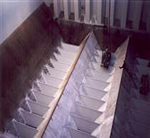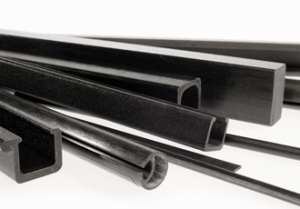SELF DISCHARGING BULK CARRIER OPERATORS SAFEGUARD THEIR ASSETS, PERSONNEL & THE ENVIRONMENT BY USING WEAR PROTECTION
27th June 2011
Source:
Kingfisher Industrial Ltd

Self discharging bulk carriers are a key component in the global commodity boom, providing fast unloading and quick turnaround to meet increasing market demands, at the same time maximising ROI for vessel operators. However, the extremely demanding operating pressures under which the carriers operate means that the benefits they provide are only sustainable if the bulk operator takes measures to counteract the detrimental effects of bulk cargoes that can be very dense, corrosive and abrasive.
From the first day that handling equipment on self-discharging vessels goes into service, its life is reduced progressively by the effects of wear, due to the nature and volumes of materials being handled. Minerals such as coal, iron ore, coke and pellets are traditionally seen as abrasive materials and are handled in quantities of millions- of- tonnes per year by loading facilities. As a result they incur significant amounts of wear that can result in extended ship layovers if not addressed. Consequently, it makes economic sense to protect against this wear.
The value of wear protection can be judged by figures from Kingfisher Industrial, a specialist in wear protection across bulk handling industries. The company has calculated that, on average, users of its wear protection systems benefit by a factor of 5 times their initial outlays, with many installations providing wear life of up to 20-years following appropriate wear treatment.
Kingfisher has a wealth of experience of providing wear protection on self unloading vessels: in the construction of new builds, dry dock refurbishment and even ‘on the run’. “The choice of liners to aid discharge and protect structures is an important decision, because not only will it maintain the asset value of the vessel handling equipment, it will also ensure demurrage costs are kept to a minimum by enabling continuous discharge at the desired rate of conveyance,” said Kingfisher MD, John Connolly. “In addition, installing an optimised lining system reduces the risk of spillages, their consequent environmental impact and clean up costs.”
“It also eliminates the thankless task of equipment repair, and takes away the requirement for crew to enter dangerous and, in some instances, confined spaces in order to undertake cleaning and clearing of material blockages at great risk to themselves and their colleagues. Furthermore, as self unloading vessels are renowned for their flexibility of operation, it is well worth investing in liners that comply to international standards associated with the handling of foodstuffs, thus preventing non-compliance.”
The vessels on which Kingfisher has provided wear protection are unique in their design, because they use gravity to discharge bulk out of the bottom of their cargo holds. Kingfisher has provided wear protection systems to protect the sloping discharge surfaces of the cargo holds, and has protected the conveyor transfer chutes that are positioned within the hull and on the deck discharge conveyor system.
The cargo holds are normally lined with a combination of paint, plastic and steel liners. After surface treatment is carried out, usually consisting of shot blasting, a paint system is applied by airless spray equipment to the vertical structure of the hold; this prevents corrosion and aids discharge due to its low coefficient of friction. The plastic liners are invariably supplied in the form of UHMWP (K-PLAS) liners, which are affixed using a variety of methods, however Kingfisher has found that a stud welding process combined with flat ‘lock-nuts’ is technically superior to other methods of attachments used. The liners are laid onto the bottom sloping surfaces of the cargo holds where angles of 50° to 40° are common. These angles don’t encourage certain materials to slide, due to the inherent moisture content, the size, shape, and in some instances, the cohesive characteristics of the product. Therefore, the surface needs to compensate for these issues; hence Kingfisher lines the surface with materials such as K-PLAS, which, with its low coefficient of friction, encourages the material to glide as opposed to bind to the surface. These liners also offer good wear resistance characteristics that counter the abrasive nature of some of the products conveyed. This, in turn, protects the structural integrity of the cargo hold.
When the holds are charged (filled) they tend to be loaded using either a conveying system or a grab. In order to limit the amount of wear that occurs during this activity, the operators of the vessel position it in such a way as to ensure that the product impacts on areas where abrasion and wear can be countered by using hardened steel liners. Kingfisher has used its K-FLOW stainless steel liner successfully in these areas, due to its processed hardness of 240HB and its low coefficient of friction, which counters degradation from product sizes of up to 450mm.
Within the conveyor network below the cargo holds, material is handled and transferred through chutes that discharge the material into reception hoppers on-shore, or alternatively, load directly into smaller vessels that can navigate into estuaries or inland water ways. Due to the tonnage rates handled by the conveyor system - sometimes in excess of 6,000 tons/per/hr (tph) - the design and protection of the system is of utmost importance in order to maintain its integrity and operating efficiency. Protecting this equipment using a range of ceramic, polymer or metallic liners is of utmost importance. Here, Kingfisher has had significant success using its range of K-CLAD metallic and K-ALOX ceramic liners. These systems counter the effects of handling materials with very abrasive characteristics, such as iron ore, coke and granite, which, due to the hardness of the mineral, degrade the surface of equipment used to convey it. During discharge, the importance of reliable effective materials handling equipment makes the difference in earning or losing money, as slow discharge rates, due to a vessel’s inability to unload at an agreed tonnage rate, costs operators income!
The value of wear protection can be judged by figures from Kingfisher Industrial, a specialist in wear protection across bulk handling industries. The company has calculated that, on average, users of its wear protection systems benefit by a factor of 5 times their initial outlays, with many installations providing wear life of up to 20-years following appropriate wear treatment.
Kingfisher has a wealth of experience of providing wear protection on self unloading vessels: in the construction of new builds, dry dock refurbishment and even ‘on the run’. “The choice of liners to aid discharge and protect structures is an important decision, because not only will it maintain the asset value of the vessel handling equipment, it will also ensure demurrage costs are kept to a minimum by enabling continuous discharge at the desired rate of conveyance,” said Kingfisher MD, John Connolly. “In addition, installing an optimised lining system reduces the risk of spillages, their consequent environmental impact and clean up costs.”
“It also eliminates the thankless task of equipment repair, and takes away the requirement for crew to enter dangerous and, in some instances, confined spaces in order to undertake cleaning and clearing of material blockages at great risk to themselves and their colleagues. Furthermore, as self unloading vessels are renowned for their flexibility of operation, it is well worth investing in liners that comply to international standards associated with the handling of foodstuffs, thus preventing non-compliance.”
The vessels on which Kingfisher has provided wear protection are unique in their design, because they use gravity to discharge bulk out of the bottom of their cargo holds. Kingfisher has provided wear protection systems to protect the sloping discharge surfaces of the cargo holds, and has protected the conveyor transfer chutes that are positioned within the hull and on the deck discharge conveyor system.
The cargo holds are normally lined with a combination of paint, plastic and steel liners. After surface treatment is carried out, usually consisting of shot blasting, a paint system is applied by airless spray equipment to the vertical structure of the hold; this prevents corrosion and aids discharge due to its low coefficient of friction. The plastic liners are invariably supplied in the form of UHMWP (K-PLAS) liners, which are affixed using a variety of methods, however Kingfisher has found that a stud welding process combined with flat ‘lock-nuts’ is technically superior to other methods of attachments used. The liners are laid onto the bottom sloping surfaces of the cargo holds where angles of 50° to 40° are common. These angles don’t encourage certain materials to slide, due to the inherent moisture content, the size, shape, and in some instances, the cohesive characteristics of the product. Therefore, the surface needs to compensate for these issues; hence Kingfisher lines the surface with materials such as K-PLAS, which, with its low coefficient of friction, encourages the material to glide as opposed to bind to the surface. These liners also offer good wear resistance characteristics that counter the abrasive nature of some of the products conveyed. This, in turn, protects the structural integrity of the cargo hold.
When the holds are charged (filled) they tend to be loaded using either a conveying system or a grab. In order to limit the amount of wear that occurs during this activity, the operators of the vessel position it in such a way as to ensure that the product impacts on areas where abrasion and wear can be countered by using hardened steel liners. Kingfisher has used its K-FLOW stainless steel liner successfully in these areas, due to its processed hardness of 240HB and its low coefficient of friction, which counters degradation from product sizes of up to 450mm.
Within the conveyor network below the cargo holds, material is handled and transferred through chutes that discharge the material into reception hoppers on-shore, or alternatively, load directly into smaller vessels that can navigate into estuaries or inland water ways. Due to the tonnage rates handled by the conveyor system - sometimes in excess of 6,000 tons/per/hr (tph) - the design and protection of the system is of utmost importance in order to maintain its integrity and operating efficiency. Protecting this equipment using a range of ceramic, polymer or metallic liners is of utmost importance. Here, Kingfisher has had significant success using its range of K-CLAD metallic and K-ALOX ceramic liners. These systems counter the effects of handling materials with very abrasive characteristics, such as iron ore, coke and granite, which, due to the hardness of the mineral, degrade the surface of equipment used to convey it. During discharge, the importance of reliable effective materials handling equipment makes the difference in earning or losing money, as slow discharge rates, due to a vessel’s inability to unload at an agreed tonnage rate, costs operators income!
Similar articles
More from Kingfisher Industrial Ltd
- Polyethylene piping has abrasion resistant lining 3rd December 2012
- Kingfisher demonstrates reduced maintenance costs and improved operational availability using latest wear protection techniques at RWM 28th August 2012
- Hillhead 2012 was bigger & better for Kingfisher! 24th July 2012
- Wear Protection Systems Deliver Longevity To Quarry Feeding, Conveying & Storage Plant 19th June 2012












Write a comment
No comments